Botanic Remedies in Colonial Massachusetts, 1620–1820*
WHEN the Mayflower landed on the Massachusetts coast in 1620, on board was a botanical book belonging to Elder Brewster, A Brief Epitomy of the New Herbal etc., first set forth in ye Dutch tongue; by Rembert Dodoens.1 No doubt this was referred to by Dr. Samuel Fuller, the ship’s physician, who was described as “well qualified in his profession.”2 It is not known if Fuller had a collegiate education, but all practitioners were familiar, to some degree, with folk medicine—the traditional pharmacopoeia.
English medicine in the early 1600’s was essentially medieval and credulous with no clear distinction between the natural, the supernatural, and the occult.3 William Harvey, having demonstrated the circulation of the blood in 1628 in a “modern” manner, thereupon concluded that the origins of the heart’s motion lay “in innate heat, which was ascribed to the soul or spirit of the blood; and this in turn was described as ‘identical with the essence of the stars.’”4 But the old medicine was slowly giving way to a new system.
Galenic theories of humors and herbal polypharmacy had been attacked by Paracelsus, who advocated chemical treatments and the concept that there were distinct diseases, each with its own causes and cures. Both Galen and Paracelsus had clear views as to the use of herbs and botanic remedies. In the Galenic theory, illness was ascribed to imbalance or impurities in the four major fluids or humors, from which was deduced a need for ridding the body of such humors by various means—bleeding, purging, sweating, and the like. Herbs, used as cathartics and sudorifics (diaphoretics), were important. Every vegetable was classified according to its properties in relation to the four humors, and to four varying degrees. For example, chicory was classified as cold in the fourth degree and pepper as hot in the fourth degree, whereas endive was cold and dry in the second degree. Galen’s work on herbs, De simplicibus, has been maintained etymologically by the old medical word “simple,” meaning an herb; and, similarly, by the word “galenical,” meaning a decoction or infusion of herbs and roots.5
Paracelsus reclaimed the ancient “doctrine of signatures” to explain which plant would “cure” a specific disease.6 According to this teleological and allegorical cryptography, plants and minerals were marked by some natural sign or symbol indicating the particular medicinal use for which they could be employed. Regarding Hypericum or Saint-John’s-wort, Paracelsus wrotc,”I have oft-times declared, how by the outward shapes and qualities of things we may know their inward virtues, which God hath put in them for the good of man. So, in St. John’s wort, we may take notice of the form of the leaves and flowers, the porosity of the leaves, the veins. 1. The porosities or holes in the leaves, signifie to us, that this herb helps both inward and outward holes or cuts in the skin. ... 2. The flowers of Saint John’s wort, when they are purified, they are like blood; which teacheth us, that this herb is good for wounds, to close them and fill them up.”7
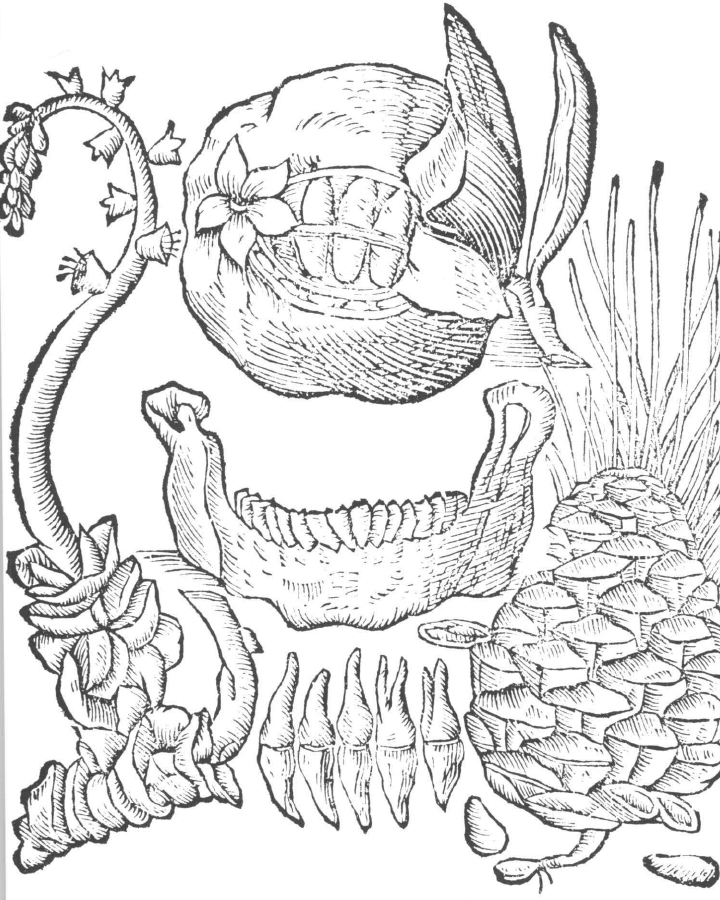
60. Plate showing scorpionlike herbs, from Iohannis Baptista Porta, Phytognomonica (1650). Courtesy Boston Medical Library.
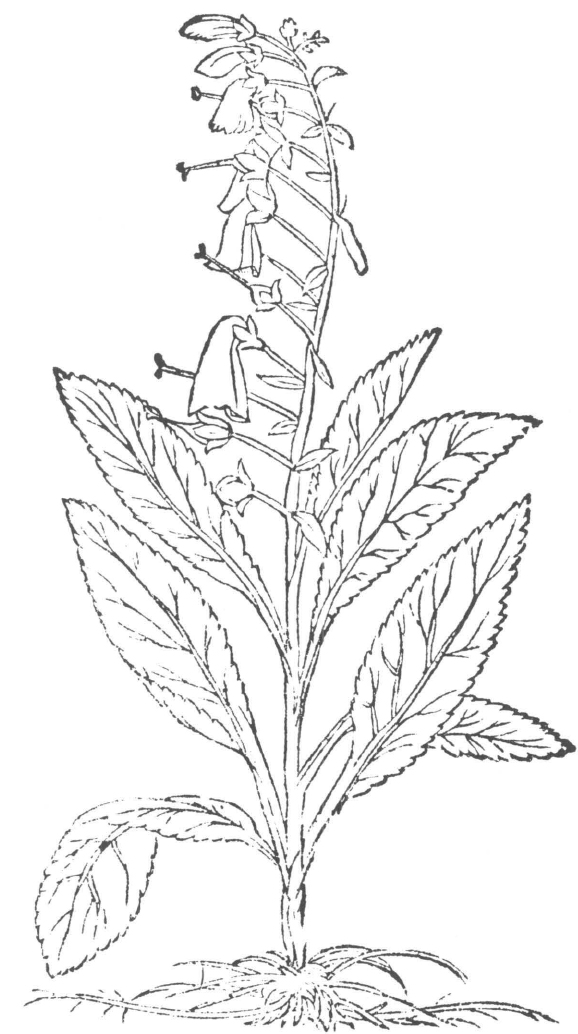
61. Digitalis purpurea, or foxglove, from Rembert Dodoens, Herbal, translated by Henry Lyte (London, 1578). In the accompanying text Dodoens notes that digitalis is useful chiefly for relieving obstructions of the four humors and, especially, for stimulating the flow of phlegm. The plant was not native to colonial New England. Courtesy Boston Medical Library.
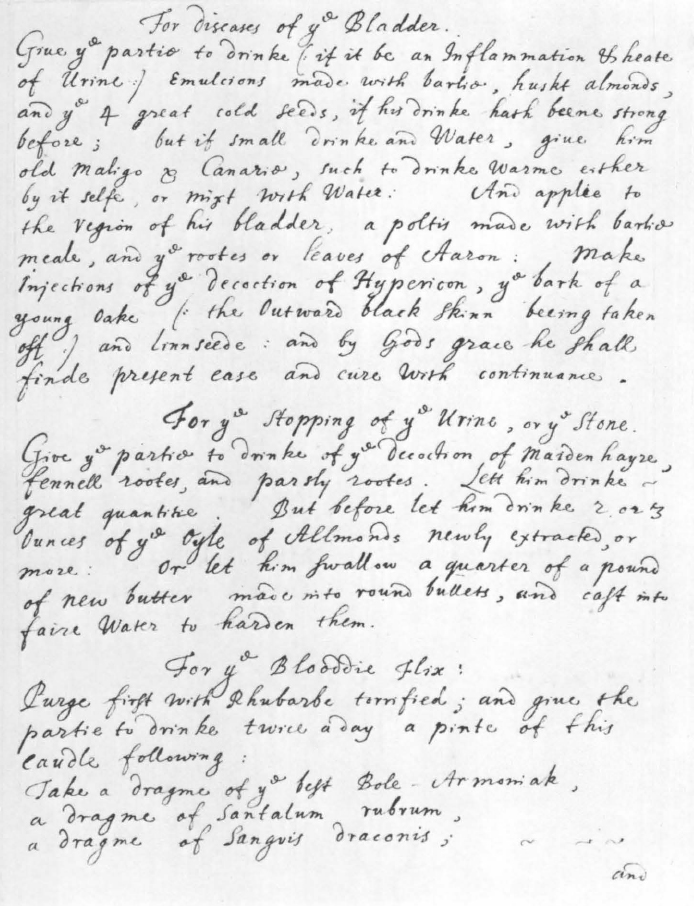
62. A page from the letter of “Medical Directions” sent by Dr. Edward Stafford of London to Governor John Winthrop in Boston, 6 May 1643. Courtesy Boston Medical Library.
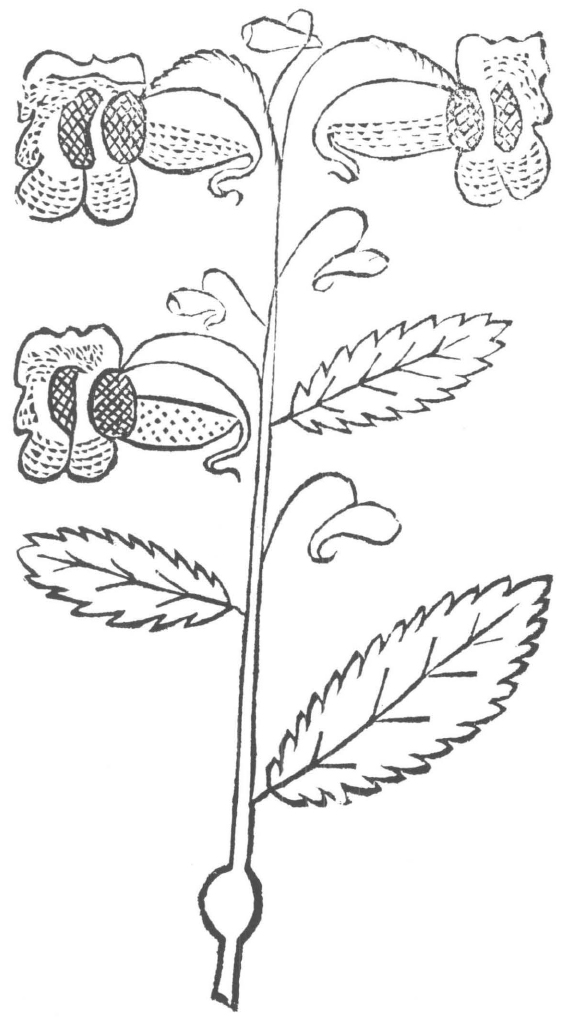
63. Jewelweed (above) and skunk cabbage (facing page), woodcuts from John Josselyn’s New-Englands Rarities Discovered (London, 1672). Compare with figure 70. Courtesy Boston Medical Library.
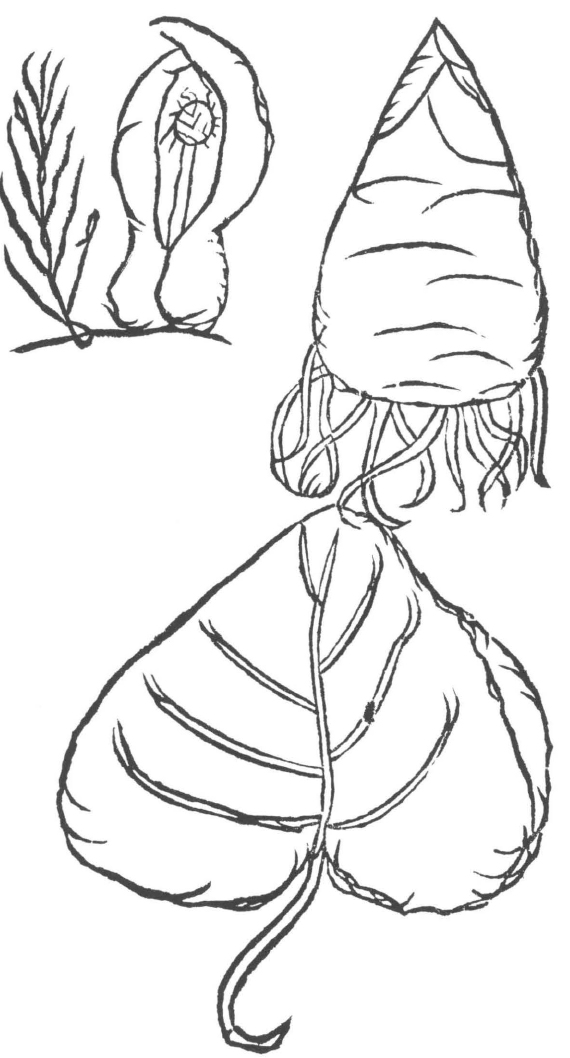
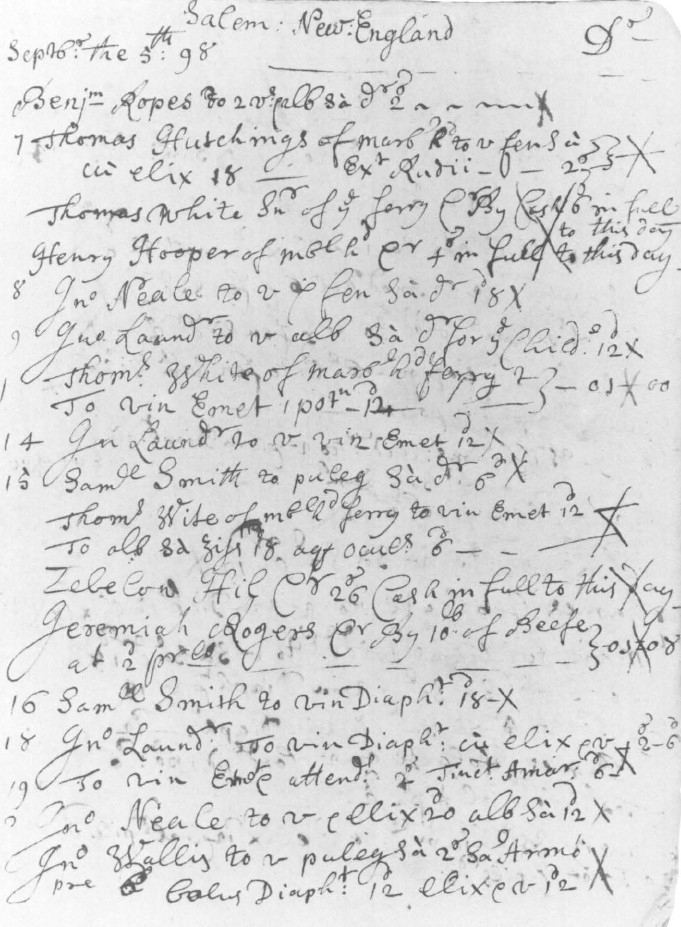
64. Page from the account book of Bartholomew Browne, apothecary in Salem, 1698–1704. Courtesy Essex Institute, Salem, Massachusetts.
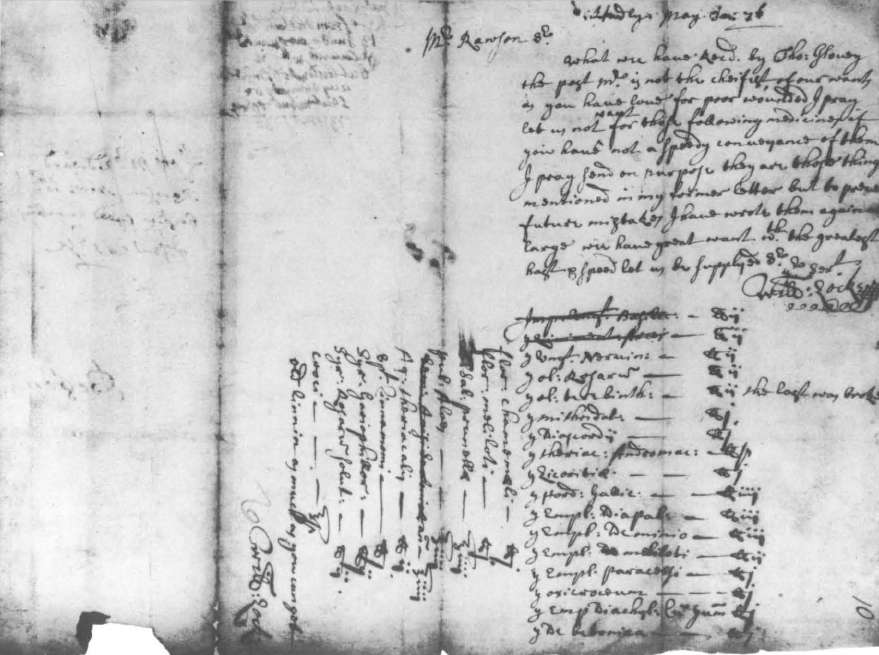
65. Request of surgeon Will Locke for drugs from the Governor and Council of Massachusetts, 30 May 1676. The letter is transcribed in Early History of Massachusetts (Boston: Massachusetts Historical Society, 1869). Courtesy Massachusetts State Archives.
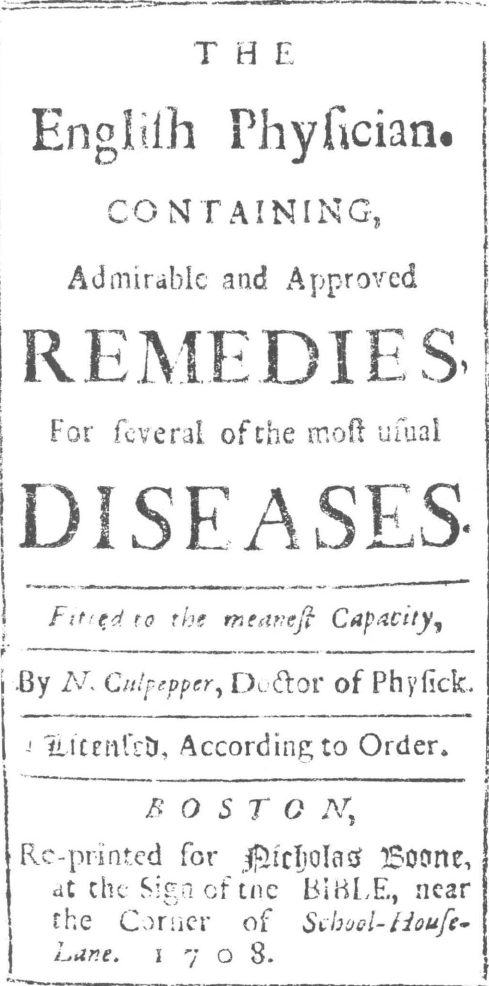
66. Title page of the Boston edition of Nicholas Culpeper’s English Physician, 1708, the first medical book published in colonial America. Courtesy Boston Medical Library.
According to his doctrine, yellow flowers such as saffron, yellow celandine, and turmeric were used for jaundice. The scorpion-grass, the old name for the forget-me-not, was efficacious for the bite of the scorpion, because the seed pod of the plant resembled the nodular tail of a scorpion; the thistle, for a “stitch in the side”; and walnut meats, because of their rough resemblance to the convolutions of the brain, would afford a natural cure for all cranial ailments. The doctrine also applied to products and minerals. The spotted skin of the lizard was a remedy for malignant tumors, the skin resembling secondary nodules; toads were used for treating smallpox, syphilis, and diseases exhibiting wartlike eruptions; bloodstone was taken as a cure for hemorrhage, and topaz as a cure for jaundice. Closely allied to the doctrine of signatures was the “sympathy cure”: “Madde Dogge livers for the bite of mad dogs,” rattlesnake livers for the bite of the rattlesnake, bear grease for baldness, and powdered mummy for prolonging life.
The Paracelsian doctrine of signatures was translated therapeutically into “curing by the assimulate,” “assimulate” being the old English word for similar. This was in contrast to the Galenic theory of “contraries cured by contraries”—for example, giving milk (being white) to clear the blood of black humors.8
Both Galenic and Paracelsian theories were espoused in the herbals that hallmarked the medical renaissance. The herbals did not confine themselves to herbs but were a “Pharmacopoeia for the poor which described for the benefit of the reader, useful substances from each of the three natural kingdoms.”9 Rembert Dodoens (1517–1585) studied medicine in France, Italy, and Germany, and in 1582 was invited to a professorship of medicine at Leyden.10 His work, Stirpium historiae pomtades sex (1583), was the basis of the most popular English herbal, The Herball or Generall Historie of Plants (1597), by John Gerard, a barber-surgeon.
The influence of Gerard’s Herball or “Gerrits Herbal” and the intermingling of Paracelsian and Galenic botanic remedies is evident in a 1643 letter of Dr. Stafford of London to the younger Governor Winthrop of Connecticut.11 The letter contains “receipts” to cure twenty disorders: madness, falling sickness (epilepsy), “for ye mother,” “Lethergie” or vertigo, disease of the bladder, stopping of urine, or stone, bloodie flux (dysentery), “janders” (jaundice), pain, broken bone, plague, smallpox, poison, fevers, old sores, burning with gunpowder, sore breasts, boils, green wound, king’s evil (tuberculosis). The botanic remedies given are twenty-four: Hypericum (Saint-John’s-wort), spurge, black hellebore, cinquefoil, bryony, “four great cold seeds,” aaron, oak bark, maidenhair, fennel, parsley, rhubarb, saffron, elm, witch hazel, elder, sempervine, foxglove, clown’s wort, jalap, scammony, snakeroot, contrayerva, and tacka-mahacha (tamarack).
The Galenic concept of humors is seen when Stafford prescribes for inflammation of the bladder or “heate of the urine.” He prescribes a “cold” remedy for the heat, recommending one of “The four great cold seeds”: from the cucumber, the gourd, the watermelon, or the melon, all fruits which are watery and “cool.” The expression “cool as a cucumber” is a Galenic holdover.12
The Paracelsian doctrine of signatures can be seen in the use of Saint-John’s-wort for burns or wounds, as described earlier by Paracelsus. Similarly, spurge was used as a purge (the leaves upward, purge; the leaves downward, vomit); saffron, the yellow flower parts of crocuses, for jaundice; toads, for tuberculosis (secondary skin lesions); and flexible twigs of witch hazel or elm for broken bones. The “law of sympathy” is demonstrated by wearing a wildcat skin for pains in the limbs and breasts.
The English herbal tradition continued with John Parkinson’s Theatrum Botanicum: The Theatre of plants, or an Herball of a large extent (London, 1640).13 In 1649 and 1653 Nicholas Culpeper published A Physical Directory or a translation of the London Dispensatory made by the College of Physicians in London. Culpeper “indulged in a vast amount of scurrilous raillery at the expense of the London Pharmacopoeia of 1618 and 1650.”14 The London Pharmacopoeia of 1618 contained 1960 remedies, of which 1028 were simples, 91 animals, and 271 vegetables.
What herbs did the early settlers of Massachusetts use? Although the Pilgrims had a copy of Dodoens’s Herbal, their only remedies would have been the garden herbs they brought with them or the medical plants that the Indians shared with them. The English women were experienced herb gatherers, and they had a lore that extended back to very early times.15 “Kitchen gardens were laid out in accordance with homeland plans. Within these gardens some of the popular medicinal herbs of the Old World were planted. Josselyn’s Account of New England (1692), ‘Of such Garden herbs (amongst us) as do thrive there, and of such as do not,’ contained about fifteen herbs which were used in contemporary English medicine, e.g., burnet, (Sanguisorba minor), groundivy (Nepetaglechoma), and feverfew (Chrysanthemum parthenium).”16
English herbs were best for English bodies: this had been the theory advanced in Timothy Bright’s A Treatise, wherein is declared the sufficiencie of English medicines, for cure of all Diseases, cured with medicines, whereunto is added a collection of medicines growing (for the most part) within our English Climate, approved and experimented against the jaundice, dropsie, stone, falling sickness, pestilence.17 But there was another concept dating back to Paracelsus, which stated that in the country where a disease arises, there nature produces the means to overcome it. This concept recurs in many herbals. In 1664, Robert Turner summed up the theory: “For what climate so ever is subject to any particular Disease, in the same Place there grows a Cure.”18 This explains why rattlesnake plantain, which grows near rattlesnake dens, is an antidote for the rattlesnake bite, and why docks grow near stinging nettles, and jewel weed near poison ivy. These are cures in situ. The idea was surely reinforced after 1640 with the introduction of cinchona bark for the treatment of malaria. It was becoming clear that new and powerful medicines were to be found in the New World flora.19
The theory of signatures also played a part in the medical theory of many American Indian tribes.20 Take, for example, the Seneca snakeroot (Polygala senega): “It seems that the plant had long been used by the Seneca tribe of Indians as a specific in cases of poisoning by the bite of a rattlesnake. They had inferred this from a supposed resemblance between the root of the plant and the rattle of the snake.”21
The settlers benefited from the skill of native healers who understood the medicinal value of many indigenous animal and vegetable products.22 Their simple remedies were quite unlike the complicated nostrums and electuaries of Europe which sometimes contained up to eighty ingredients. Such an uncomplicated approach encouraged the settlers to establish an independent tradition of prescribing a specific remedy for a specific ailment. It also caused them to gradually shift from relying on the European schoolmen to depending on the simples and specifics of the old wives, Indians, and ministers. The contributions of the Indians can be gauged by the fact that of the fifty-six Indian drugs holding recognition in 1925, thirty of them had been used by the Indians of New England.23 “Native American medicine was not, therefore, in conflict with the technique introduced by the first practitioners. Instead, there was a favorable exchange of ideas, a factor which obscures the derivation of many of the colonial remedies.”24 As early as 1588, Hariot reported that sassafras was “of most rare vertues in physick for the cure of many diseases,” that tobacco “purgeth superfluous fleame and other gross humors,” and that “sweet gummes of divers kinds” were also used.25
In 1602, Bartholomew Gosnold and his crew landed in Massachusetts to load the first cargo of New England exports, which consisted of the bark and the pith of the sassafras tree. The same year Sir Walter Raleigh returned from Cape Fear with a cargo of timber, sassafras, china root, benjamin (spicebush), sarsaparilla, cassis lignea, and an unknown “strong bark.” Sassafras was exported throughout the colonial period; in 1770 alone, England imported nearly seventy-seven tons of it.26 Peter Kalm, in his Travels, relates that in earlier days the Englishmen had been fond of drinking sassafras tea, but when it became common knowledge that such a decoction was a treatment for syphilis, they stopped for fear that others would think them diseased.27 The collection, cultivation, and exportation of plant drugs such as ipecac, Virginia snakeroot, and ginseng were of considerable economic significance in the colonies.28
The first record of Indian herbal medicine was by John Josselyn, an English botanist, explorer, and practitioner of medicine. Josselyn came to New England in 1638, stayed for eighteen months, returned in 1663, and remained eight years. In 1672 he published his New-Englands Rarities Discovered: In Birds, Beasts, Fishes, Serpents and Plants of that Country. Together with the Physical and Chyrurgical Remedies wherewith the Natives Constantly use to Cure their Distempers, Wounds, and Sores. Josselyn describes the diseases to which the Indians were subject and he relates the plant remedies they used.29 Among them was the white hellebore: “The Indians cure their wounds with it, anointing the Wound first with Raccoons greese, or Wild-Cats greese, and strewing upon it the powder of the roots; and for Aches they sacrifice the grieved part, and annoint it with the aforesaid Oyls, then strew upon it the powder: The powder of the Root put into a hollow Tooth, is good for the Tooth-ach: The root sliced thin and boyled in Vinegar, is very good against Herpes Milliaris.” Josselyn reported that “the bark of Birch is used by the Indians for bruised Wounds and Cuts, boyled very tender, and stampt betwixt two stones to a Plaister, and the decoction thereof poured into the wound; And also to fetch the Fire out of Burns and Scalds.”30 Of one of the New World’s most famous flora he wrote that “the virtues of Tobacco are these, it helps digestion, the Gout, the Tooth-ach, prevents infection by scents, it heats the cold, and cools them that sweat, feedeth the hungry, spent spirit restoreth, purgeth the stomach, killeth nits and lice. . . .”31
The following excerpt from Josselyn is an example of how plant lore was transmitted to the colonists: “One Christopher Luxe: a fisherman having burnt his Knee Pan, was healed again by an Indian Webb, or wife (for so they call those Women that have husbands;) She first made a strong decoction of Alder bark, with which she took out the fire by Imbrocation, or letting of it drop upon the sore, which would smoak notably with it; then she Playstered it with the Bark of Board Pine, or Hemlock Tree, boyled soft and stampt betwixt two stones, till it was as thin as brown Paper, and of the same Colour, she annointed the Playster with Soyles Oyl and the Sore likewise, then she laid it on warm, and sometimes she made use of the bark of the Larch Tree.”32
Peter Kalm (1715–1779) was a Swedish naturalist, a student of Linnaeus, who visited the colonies in 1748 and remained for two and a half years. He collected plant specimens and observed social conditions in colonial America from Philadelphia north to Quebec. In his observations on life in colonial America, he described the remedies being used by the colonists, and he specifically remarked on remedies learned from the Indians as well as remedies that the colonists used when they were unable to find European plants and were forced to substitute native plants. One remedy which the colonists used as a substitute for an unavailable plant was the root of the tulip tree; Kalm said that “many people believe its roots to be as efficacious against the fever as Jesuit Bark.”33 Jesuit missionaries in South America in 1632 had learned of the value of the bark of the cinchona tree, thus its appellation, “Jesuit Bark.”
Another Indian remedy described by Kalm was the use of the seed capsules of the Virginia Anemone for the ache occasioned by a hollow tooth. The method consisted of rubbing the seed capsules so that they looked like cotton, soaking them in strong brandy, and placing them in the tooth.34 Another remedy was told to Peter Kalm by John Bartram, who heard of it from Conrad Weisser, an interpreter of the Indian language. He said that “he was once among a company of Indians, one of which had been stung by a rattlesnake, the savages gave him over; but he boiled the Collinsonia (Blue-eyed Mary) and made the poor wretch drink the water, from which he happily recovered.” He also related that, in other parts of the country, the plant is called horseweed, illustrating the practice of different sections of the country having different names for the same plant.35 In one of his papers on natural history, Kalm published, in 1750, an account of “Lobelia as a sure remedy against venereal disease.”36
The role of the minister in the practice of medicine in colonial Massachusetts was of great importance. Two ministers who specifically concerned themselves with botanic remedies were the Reverend Cotton Mather and the Reverend Thomas Harwood. Mather was most interested in Indian medicine. He was convinced that God had placed remedies in each part of the world where they were appropriate, and since the Indians had dwelt long in America, they might well have been the first to find the blessings peculiar to their continent. In 1723 he wrote “that for our physick, as well as for our food, Every Creature of God is good, and nothing is to be refused, if it be received with Thanksgiving.” In a letter, Mather discussed unique American plants with which “our Indians do cures many times which are truly stupendous.”37
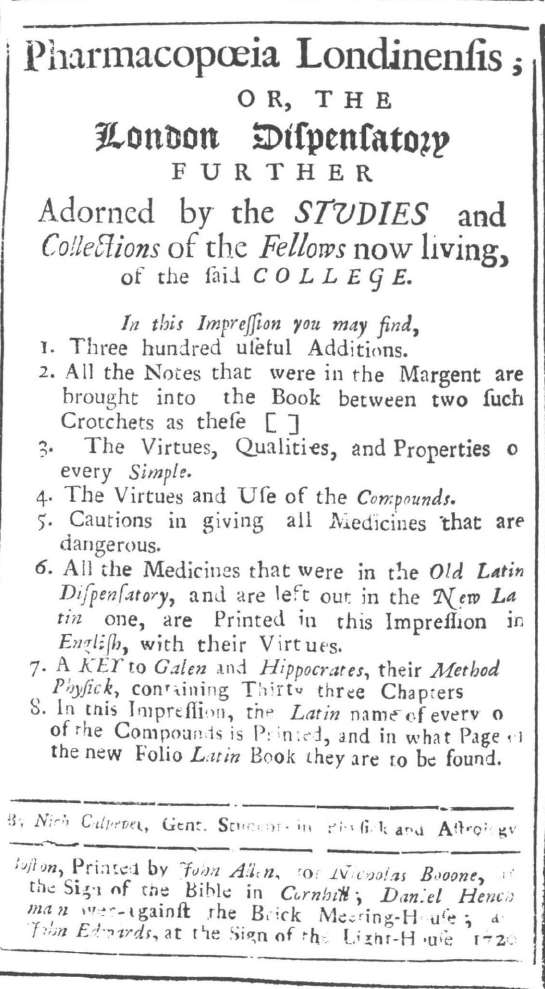
67. Title page of Boston edition of Nicholas Culpeper’s Pharmacopoeia Londinensis, 1720, widely used in colonial Massachusetts. Courtesy Boston Medical Library.
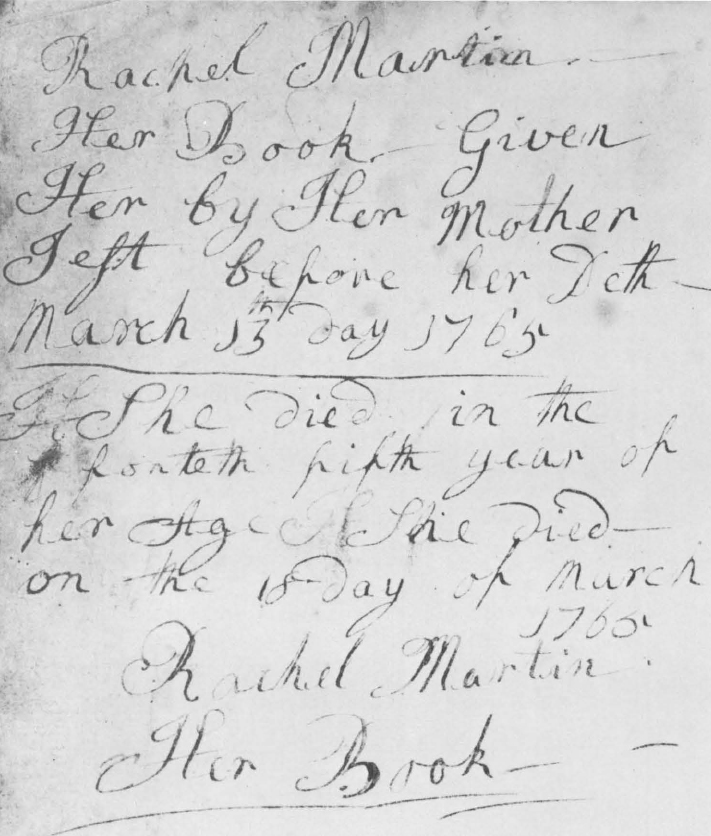
68. Inscriptions in Rachel Martin’s copy of Culpeper’s Pharmacopoeia Londinensis, the title page of which appears in figure 67. This book was popular with colonial housewives. Courtesy Boston Medical Library.
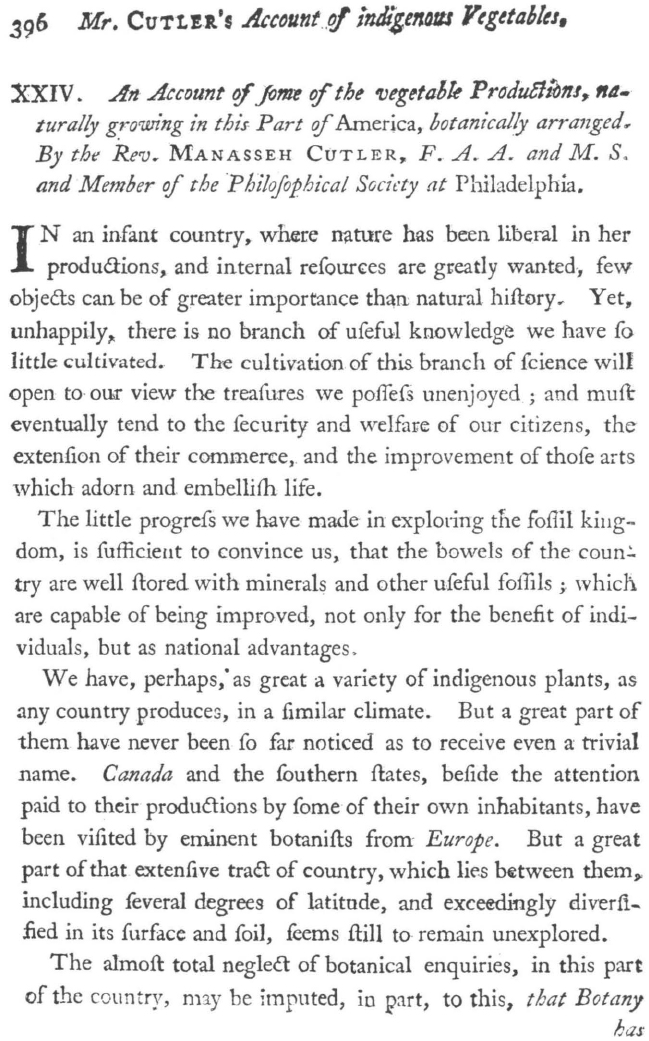
69. First page of Manasseh Cutler’s Account of Some of the Vegetable Productions Naturally Growing in this Part of America (Boston, 1785). Courtesy George E. Gifford, Jr.
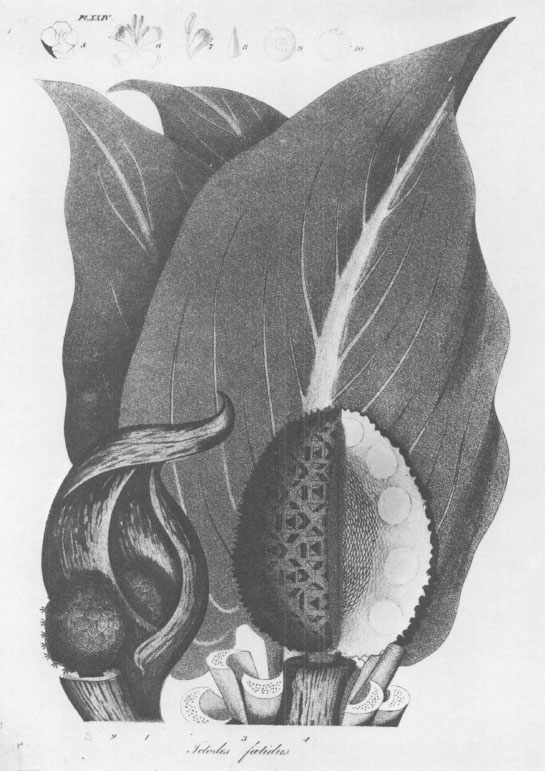
70. Plate of skunk cabbage from Jacob Bigelow, American Medical Botany (Boston, 1818). Compare with figure 63. Courtesy Boston Medical Library.
Mather reported an Indian tea of Fabiana efficacious for cancers and fevers. Other Indian cures included partridgeberry, as a powerful diuretic which would cure dropsy; “throatweed,” helpful in sore throats; “cranesbill,” which, when brewed into a tea, would heal lues venerea in two weeks; and “Bleeding root,” which could cure jaundice within six days.38 His Angel of Bethesda, meant to serve as a “family medical manual,” was addressed to physicians and the public. It has been suggested that it was never published because it fell between the schools of “professional and popular appeal.”39
The Reverend Thomas Harwood, Lecturer at the King’s Chapel in Boston and Licentiate of the Royal College of Physicians in London, published his Electuarium novum Alexipharmacum, Or, A new cordial, alexiterial and restorative electuary; which may serve for a succedaneum to the grand theriaca andromachi. The Theriaca examined, with reasons humbly offered why the troches should be ejected, as well as a great number of the rest of the ingredients. A new correlation of theriaca most humbly proposed . . . (Boston, 1732).40 Theriaca was considered an antidote to poison, compounded of many drugs and honey.
Two documents, the Account Book of Bartholomew Browne41 in the Essex Institute in Salem, Massachusetts, and the Drug List of King Philip’s War42 in the Archives of the State House in Boston, Massachusetts, when placed in juxtaposition, present an excellent “point-counterpoint” of medical practice in the colonies. The drug list describes medical practice as seen by a newly arrived “chirurgeon,” whereas the Browne account book is a unique document, for it is the first record of business transactions in pharmacy in New England.
Bartholomew Browne was a “pharmaceutical-chemist” who practiced as a pharmacist and occasionally made visits as a physician. He was one of three apothecaries in Salem, where there were four physicians, at least three of whom were his customers. Careful perusal of his account book reveals that Browne’s “medical armamentarium” was uniquely chemical in nature. During the period of June 1698 through December 1704, he dispensed no less than 335 pots of “alb Samech” (white Samech). It is not remarkable that there would be extensive use of tartar as a cure for many ills; most of the medical texts from Europe advocated its use. (It was recommended by Salmon, Paracelsus, Boerhaave, and others.) However, in addition to white Samech, Bartholomew Browne prepared a unique series of herb preparations with tartar which are not to be found in any of the standard texts or pharmacopoeias of the day. Browne sold 326 pots of an unidentified “Elixir Proprietas.” (According to Salmon,43 Elixir Proprietas was composed of aloes, myrrh, and saffron prepared with a “Tartarized Spirit of Wine.”) Other dispensations of Browne included a cordial powder (to strengthen and comfort all the natural, vital, and animal powers), preparations to dispel worms, emetics, and other less-frequently-prescribed medicines.
Dr. William Locke arrived in Boston from England in 1675 and apparently lost no time in offering his services to the colony at the outbreak of King Philip’s War. Locke was in Hadley, Massachusetts, caring for the wounded and ill soldiers, when he wrote an urgent letter to Mr. Rawson, Secretary of the Massachusetts Bay Colony, stating that this was his second letter requesting urgently needed supplies. It is assumed that the order of drugs was to be sent from England, because the items requested seem more complex than could be compounded in the colonies. Practically all the items requested are to be found in the London Pharmacopoeia of 1650; one medicine requested contained no less than fifty ingredients. Locke appealed for opiates, stimulants, cathartics, plasters, and “old linnen as much as you can get” for bandages. By comparing the newcomer Dr. Locke’s drug list to the established Bartholomew Browne’s list of dispensations, we see the beginning of independence from the standard European pharmacopoeia.
Books giving advice for self-treatment as well as for the cultivation of herbs were much cherished and used by the English emigrants. The most important of these was Gervase Markham’s The English Housewife Containing The inward and outward Vertues which ought to be in a Compleat Woman as her skill in Physicke, Chirurgery, Cookery, Extraction of Oyles Banqueting stuff, Ordering of Great Feasts and The English Husbandman (1613).44 Another was Nicholas Culpeper’s The English Physician (London, 1652), which was reprinted again and again and used for more than a century.45 In 1708, a work of the same title and attributed to Culpeper was published in Boston, a tribute to the work’s popularity. The work was “obviously intended for the layman and presented what purported to be Culpeper’s ‘choicest secrets.’ . . . The remedies were domestic and largely, though not entirely, herbal. Thus, for ‘Pains and Aches in the Back, Hip, Sides, or any part of the Body,’ one remedy was a concoction of Syrup of Poppy, Syrup of Betony, and Waters of Bugloss and sage. Another included the following directions: ‘Take the Gall of an heifer for a Man; the Gall of a Steer for a Woman, Brandy, or each a like Quantity, boyl them together ‘till it begin to be clammy, and before the Fire with a warm hand strongly bathe the Party Morning and Evenings, ’till he be whole.’”46
The second American medical book was a reprint of Nicholas Culpeper’s Pharmacopoeia Londinensis or The London Dispensatory, published in Boston in 1720. “This is a very significant book; not only was it the first full length medical work published in the colonies but was also the first work of a pharmacopoeial or dispensatory nature.”47 The work is indebted to the “old” pharmacopoeia of 1618, and the “new” pharmacopoeia of 1650. The “Catalogue of Simples” is from the 1650 edition. Roots are classified as “hot” in four degrees, “temperate,” “cold” in three degrees, “dry” in four degrees, and “moist.” Then the roots were classified by the parts of the body they affected; those that heated the head, the neck, and the throat, the stomach, and the bowels. Next they were classified by their “properties,” e.g., those that mollified, glutinated, and purged.
According to Sonnedecker, the book apparently attained no professional status. However, these books must have been treasured by the colonial housewife. “A London edition of 1667, for example (in the Boston Medical Library), bears a fly-leaf notation that the book was given to Grace Greenleaf ‘by her honoured Mother ... in the year 1764.’ The same book noted that Grace gave it to her sister Elizabeth two years later. A copy of the Boston edition of 1720 (in the same library) bears the notation, ‘Rachel Martin, Her Book, Given Her by Her Mother Jest before her Deth, March 13 th Day 1765.’”48
Later in the century William Buchan’s Domestic Medicine (London, 1769) was so popular that it was published at least fifteen times in the colonies and the new United States between 1771 and 1799, and many times afterward.49 A New Haven edition published in 1816 was called Every man his Own Doctor; or a Treatise on the Prevention and Cure of Diseases, by Regimen and Simple Medicines. To Which is Added, a Treatise on the Materia Medica; in which the Medicinal Qualities of Indigenous Plants Are Given and Adapted to Common Practice. With an Appendix, Containing a Complete Treatise on the Art of Farriery. With Directions to the Purchasers of Horses; and Practical Receipts for the Cure of Distempers Incident to Horses, Cattle, Sheep, and Swine—to all which are added, a Choice Collection of Receipts, Useful in Every Branch of Domestic Life—Making it All a Complete Family Directory.50
The self-help tradition had an American exponent in New England’s own Dr. Samuel Stearns (1741–1809).51 Born in Bolton, Massachusetts, he began the practice of medicine at the age of thirty years, in Paxton, Massachusetts. He was a prolific and expansive writer for The North-American’s Almanack being the Gentlemens and Ladies Diary for the year of Christian Aera, 1771. . . . Also, a variety of excellent medicines, extracted from authors, shewing an easy way of curing diseases, with an account of the wonderful operations of the Bite of a Mad Dog on the Human Body, and directions for working the cure of the same, &c, &c. Accused of being a Tory, Stearns escaped from Paxton and took the Oath of Allegiance to the King before the mayor of New York. He practiced in New York and Long Island. After the war, he returned to Paxton and was jailed in Worcester for three years. He then moved to Brattleboro, Vermont, and Quebec; in 1790, he went to England and Paris. On 2 October 1790 Stearns obtained a Doctor of Laws degree from Aberdeen University. Of this degree it was written, “In America it is not generally known that for twelve pounds two shillings and six pence, sterling, any creature can obtain in the University of Aberdeen and at St. Andrews a diploma, which will dignify the possessor with a Doctor’s Degree in Divinity, Law or Physic. . . .”52
After returning to the United States, he continued a peripatetic medical career in Connecticut, Vermont, and Rhode Island, continuing to write and practice. His magnum opus was his book of 1801, The American Herbal, or Materia Medica, Wherein, the Virtues of the Mineral, vegetable, and animal productions of North and South America are laid open, so far as They Are Known: and Their uses in the practice of physic and surgery exhibited. In the Preface to the American Herbal, Stearns observed that medical books, having been written at various periods, “frequently gave different accounts concerning the virtues, operations and effects of medicines, upon the human body; the description of diseases, and the methods of prescribing remedies for their ‘cure,’ that there was no established rule ‘in America’ for a guide to the apothecaries in compounding their medicines,” and “that the methods of instruction were likewise different, amongst the different teachers of the healing art.”53 Also in the Preface he gives a list of books that “ought to be spread through all the regions of the medical world, that the mind of our practitioners may be illuminated, and their practice regulated.”54 The list includes: Pharmacopoeia Londinensis; Lewis’s Materia Medica, in quarto; Cullen’s Nosology; Motherby’s Medical Dictionary; London Practice of Physic; Practice of the London Hospitals; Wallis’s Works; Transactions of the College of Physicians in Philadelphia; Rush’s Medical Enquiries; Bartram’s Botany; Dictionary of Arts and Sciences.
John C. L. Clark’s evaluation of Stearns’s book is ambivalent: “The American Herbal ... is confined to medicines indigenous to America. I think you would call him a ready writer rather than a thinker, an organizer rather than an observer. It is greatly to his credit that he organized the idea of compiling a dispensatory for the Colonies, and that he published his ‘Herbal’ of indigenous drugs; but he did not use well the material which he says he studied.”55 With Stearns, the United States had produced its own Nicholas Culpeper, a “doctor” writing in the time-honored self-help tradition.
Also within this self-help tradition was Methodist theologian John Wesley’s Primitive Physic (London, 1747) which was reprinted many times.56 As an educated reformer, Wesley’s concern was to provide a book of safe, effective remedies that were available to the common man. Wesley himself was Oxford-educated, but his volume was in rebellion against the men of science, especially those who practiced physic.
To introduce his book, Wesley hearkened back to the “original sin” concept; he maintained that God provided illness and pestilence as part of the punishment for the sinfulness of man. Further, he felt that God, in his goodness, provided the cures for these diseases in a place nearby. Wesley’s concepts closely paralleled the old doctrine of signatures. For example, in describing a village cursed with sores of the mouth, he related that one of the villagers was walking in a forest when a drop of the tar from the pine tree fell onto his sore mouth. Immediately, he was relieved and was able to tell others of the “cure.”
Wesley said that for these simple, “primitive remedies” to be effective, one must lead a simple life: Fear God, get plenty of exercise, keep clean, and exercise temperance in all things. He allowed that one might consult a “God-fearing” physician if one did not know the nature of an illness, but implied that this should occur only rarely. Most of Wesley’s remedies remind one of the remedies from the old herbals and self-help books, as well as the folklore and Indian remedies. He even pointed out that the Indians were seldom ill and said this was due to their “continual exercise” and “universal temperance.” Wesley further states that if the Indians did become ill, the fathers told the children what remedy to apply. The Reverend Wesley stated that the practice of physic became complex and abstruse so that the physicians could become wealthy and powerful. His book, originally published in London in 1747, was printed in America at least seven times between 1764 and 1795. This book was another that facilitated the separation of American dependence on European medical theory and drugs.
Early colonial botanic remedies were, then, composites of several distinct traditions intermixing, tempered by the American environment with its own flora. There was the “kitchen physic” that grew out of the leech and “good woman” tradition; there was the Indian materia medica; there was the flood of self-help books by authors such as Culpeper, Buchan, and Wesley; there was the “Angelic Conjunction” or the physician-minister who suffused the decoction with theological endorsement; and there were the official remedies based on the English pharmacopoeias, which were, in turn, based on the dying Galenic theories and the new theories of Sydenham, who advocated specific cures for specific diseases. These varying traditions were fused by a long period of empirical, largely self-administered, and, consequently, independent evaluation.
One of the most significant contributions to colonial botanic remedies was made by the Reverend Manasseh Cutler.57 Cutler (1742–1823), of Hamilton, Massachusetts, was born in Killingly, Connecticut. Graduated from Yale University in 1765, he practiced law, then studied theology. In 1779, he wrote that money had depreciated so much that he had spent a considerable part of his estate in support of his family and so was “driven to the practice of physic.”58 He read medicine assiduously, studied anatomy, prepared medicines, and attended the sick in addition to his usual pastoral duties. One can speculate that his botanical interest may have arisen from his study of physic, for it was in 1780 that he first mentioned his interest in plants; he borrowed Catesby from the Harvard Library. In 1781, Cutler wrote to Harvard asking to borrow Dr. Hill’s Natural History. (John Hill [1716–1775] issued a huge botanical work of twenty-six volumes, The Vegetable System, with 1600 copperplate engravings, from from 1759 through 1775.)59
Withering published his Botanical Arrangement of British Plants in 1776 and that must have been one of the volumes that Cutler studied when he read physic and botany.60 In 1785 Manasseh Cutler presented his paper “An Account of Some of the Vegetable Productions naturally growing in this Part of America, botanically arranged” to the American Academy of Arts and Sciences.61 The American Academy of Arts and Sciences was organized by a group of scholars in and around Boston who felt the need for a “learned society.” Its first meeting was on 31 January 1781, and Manasseh Cutler records the meeting and says that he “had the honor of being elected a member.”62 The Academy hoped to attract papers on basic science and “promote useful knowledge.”
In presenting his paper to the Academy, Cutler said that he had arranged it according to the Linnaean system, that the “medical and economic uses which are mentioned, are inserted from the best private information that could be obtained, or selected from good authorities; many of them, in particular, from a late ingenious and useful publication by William Withering, m.d., entitled, ‘The Botanical arrangement of British Plants.’”63 Dr. Cutler included only plants that were growing within the compass of a few miles, all in New England. He decries the lack of any botanical publication about the plants of his area, and says it may be due to the fact that botany “has never been taught in any of our colleges.” Further, he says, “the grossest mistakes have been made in the application of English names of European plants, to those in America.”
In all, the Reverend Cutler entered 328 different species; of that number he had entries describing medical uses for eighty-five of them, some having more than one medicinal effect. In his entries regarding medical effects, he refers most often to Dr. Withering, twenty-three times. Cutler also records remedies used by the Indians, and refers to other sources, namely, Hill, Linnaeus, Boerhaave, and Cullen. The reader may further assume that some of the remedies arose from his own experience as a physician.
One of the plants Cutler described was Salix: “The white Willow. The Red Willow. The Rose Willow. The Dogwood. The Osier. An account is given in Transactions of the Royal Society (vol. I, iii, p. 195) by the Rev. Mr. Stone, of the great efficacy of white willow bark in curing intermittent fevers. He gathered the bark in summer, when it was full of sap; dried it by a gentle heat, and gave a dram of it powdered, every four hours between the fits. In a few obstinate cases he mixed it with one fifth of Peruvian bark. Some judicious physicians, here, have made trial of the bark of the white willow, and recommend it as a valuable substitute for the Peruvian bark. They have used principally the bark of the roots.”64
Among Cutler’s many correspondents was Dr. Jonathan Stokes, a botanist of note and a contemporary of Withering whom he had assisted in preparing his work. Stokes himself authored a botanical materia medica published in London in 1812. Dr. Cutler also corresponded with Benjamin Smith Barton, Professor of Natural History and Botany in the College of Philadelphia, and author of many works on botany and materia medica.65 Dr. Henry M. Muhlenberg, a minister from Pennsylvania who was especially distinguished in the study of botany, wrote to Dr. Cutler asking for his paper on the plants of Massachusetts. The two exchanged scientific information and botanical specimens.66 Another correspondent was Professor C. S. Rafinesque; he studied botany and published Medical Flora (2 v., 1828.67 Cutler was in the minister-physician tradition, or, as Cotton Mather called it, the “Angelic Conjunction.” His correspondent, H. Muhlenberg, too, was in this fraternity. Two of his other correspondents, Barton and Rafinesque, were physicians beginning to take note of the indigenous American materia medica, but Cutler’s work was the first serious study of New England plants and their medical uses.
It was inevitable that an American pharmacopoeia or Materia Medica would be compiled with a list of native botanical remedies by the regular medical practitioners rather than by the “clergyman-physician” Cutler or that American original, “Dr.” Stearns. In 1751, Benjamin Franklin recognized the need for a home herbal, and reprinted Thomas Short’s Medicina Britannica: or A Treatise on such physical Plants as are generally to be found in the fields or gardens in Great Britain: containing a particular account of Their nature, virtues, and uses. The Franklin reprint of the third edition was With a preface by Mr. John Bartram . . . and his notes . . . Showing the places where many of the described plants are to be found in these parts of America, Their differences in name, appearance and virtues, from those of the same kind in Europe; and an appendix, containing a description of a number of plants peculiar to America, Their uses, virtues, &c. The second title of this work is Descriptions, virtues, and uses of sundry plants of these Northern parts of America, and particularly of the Newly discovered Indian cure for the venereal disease.68 In the Appendix, there are sections on the gathering, drying, and preserving of plants, and on the preparation and use of domestic remedies. Bartram’s Appendix includes descriptions and uses of spikenard, wild sarsaparilla, fleabane, lizard tail or water dragon, horsebalm or stoneroot, bloodroot or puccoon, bellwort, tinkerweed or feverwort, stargrass or colic root, dogbane or Indian hemp, great blue lobelia, speedwell, and the Eupatoriums, Joe Pye weed and boneset.69 Bartram’s Indian cure for “the venereal disease” was Lobelia siphilitica or the great blue lobelia. It has been stated that this plant was the secret remedy of the American Indians, the secret having been purchased from them by Sir William Johnson (1715–1774), the British soldier and American pioneer who was appointed superintendent of the Six Nations. Both Kalm and Colden probably learned of lobelia as an “antisyphilitic” from Bartram.70
In Boston, in 1750, William Douglass (1691–1752)71 was the leading physician, and the only physician who had received the M.D. degree, having studied in Edinburgh, Paris, and Leyden. A Scotsman, he came to Boston around 1718 and, according to Viets, began his study of botany in Europe. Douglass wrote, “In the country near Boston, I have collected and described about eleven hundred indigenous species of plants, perhaps a few of them might be casually imported from Europe.”72 Douglass also stated that witchcraft referred to the study of poisons and qualities of herbs; thus, herb women were witches!73
But what of Douglass’s use of botanical drugs? Did he use American indigenous plants as did his correspondent Cadwallader Colden (1688–1776)? Another Scotsman with an Edinburgh M.D., Colden lived in New York state, corresponded with Linnaeus, John Bartram, Alexander Garden, Peter Collinson, and Jan Frederick Gronovius. Like Douglass, Colden collected plants around his home in Orange County, New York, but unlike Douglass he published his botanical works in the Acts of the Royal Academy of Uppsala (1749, 1751) wherein he described over three hundred American plants. Colden also wrote on medical botany, advocating poke as a cure for cancer; he also reported “on the virtues of the great water dock,” and on the antisyphilitic properties of the great blue lobelia. Was it from Colden that Douglass learned of Alexander Garden’s use in Charleston of the Indian pink, pinkroot, or warm grass as an anthelminthic, a remedy learned from the Cherokee Indians? Did he read “An Epistle to Dr. Mead concerning the Seneca Rattle-snake root,” by John Tennent, his Virginia counterpart, in the Edinburgh Medical Essays and Observations!74
Perhaps Douglass gleaned some of his information from William Salmon’s Pharmacopoeia or New London Dispensatory (1678)75 (we know that the Mathers owned this volume) or from the Edinburgh Dispensatory (published originally in London with other editions, 1699, 1722, 1735, 1744, 1756, 1774, 1788, 1792, 1803, 1817; by 1805, five reprints had appeared in America).76 Although we do not know of Douglass’s botanical remedies, we do know about his dispensing of such drugs. He wrote to Colden, in 1722, “We abound with Practitioners, though no other graduates than myself, we have fourteen Apothecary Shops in Boston, all our Practitioners dispense their own Medicines.”77
After the Revolutionary war, one of the needs of the new nation was to derive the greatest possible benefit from the natural resources of the country. Johann Schoepf, a German soldier in the English service and a physician-botanist, stayed in the United States to study its indigenous materia medica.78 He traveled through the country for more than a year and published, in 1787, Materia Medica Americana Potissimum Regni Vegetabilis. Schoepf’s work is based largely on the observations of the excellent American botanist G. H. E. Muhlenberg and the work of Bartram, John Clayton, Colden, Kalm, Catesby, and others. Schoepf wrote to Muhlenberg, “My lists (describing about 400 North American plants) make it certain that North America owns a rich indigenous materia medica in her plants and can find all she needs, apart from a few East Indian spices and plants, on her own soil.... I almost flatter myself in writing this little book to have rendered sufficient services to America to be pardoned for my assistance in combatting her.”79
The first medical school in the North American colonies was founded in Philadelphia, in 1765, only a short time before the outbreak of the Revolution. Dr. John Morgan, Professor of Medicine, also taught materia medica and botany. The botany was taken over in 1768 by Dr. Adam Kuhn, who had studied under Linnaeus.80 Apparently, he did not like botany and gave it up after one year, when he was replaced by Benjamin Smith Barton (1766–1815). Barton authored Collections for an Essay towards a Materia Medica (1798–1804), the first American materia medica, as a critique of the work of Schoepf. Barton also edited for the use of students and physicians in the University of Pennsylvania William Cullen’s Treatise of Materia Medica in 1812, adding notes on the uses of American plants. Medical botany was now becoming a part of American medical education.
At the Harvard Medical School, founded in 1782, Benjamin Waterhouse became the Professor of the Theory and Practice of Physic. Waterhouse dabbled in botany and wrote Heads of a Course of Lectures on Natural History (1810) and The Botanist81 (1811). He added absolutely nothing to medical botany; the use of botanical remedies that Waterhouse recommended to his students is revealed by his hortus siccus or herbarium, now at the Countway Library.82 Of the 220 specimens in this undated book, seventeen have medical annotations. A few examples will suffice:
- 1. Arum. The root is an excellent medicine but must be used when fresh.
- 2. Datura stramonium. The extract from this herb has proved to be the most successful remedy in spasmodic disorders. The subscriber having seen it cure the most obstinate hysterical complaints that were as violent as those of epilepsy. Dose from ½ grain to 3 grains observing accurately when the pupil of the eye dilates.
- 3. Phytolacca. Doctor Colden’s specific against cancer. The root may be given internally and has succeeded to use in gout and other obstinate disorders.
- 4. Blood root. The root of this plant is an excellent medicine that will be of great use in the practice. Given in the dose of 6 grains it acts as an emetic and if the quantities be lessened to the half part it is an excellent diaphoretic.
Benjamin Waterhouse was removed as Hersey Professor at Harvard in 1812, and Jacob Bigelow, m.d. (1787–1872), succeeded to the public lectures in botany in Boston. As a Harvard undergraduate, Bigelow had been introduced to anatomy through the lectures of Dr. John C. Warren and discovered that “a physician might be fluent and accomplished and serve his generation in other ways than as a mere vehicle of pills and plasters.” In 1809 he chose to go to the University of Pennsylvania to study with the famous doctors, Rush, Wistar, Physick, and Barton, who stimulated his interest in botany. Back in Boston in 1810, Bigelow made a collection of plants within a ten-mile radius of Boston that he described in his first book, Florula Bostoniensis (1814), described as “the first distinctive local flora published in America.” In 1815 he was appointed Lecturer in Materia Medica and Botany at Harvard.83
In 1817, 1818, and 1820, Bigelow’s three-volume classic appeared: American Medical Botany, Being a Collection of the Native Medicinal Plants, Concerning their Botanical History and Chemical Analysis, and Properties and Uses in Medicine, Diet, and the Arts, with Coloured Engravings. Bigelow incorporated the colonial botanical tradition; he quoted Gerard, Linnaeus, Schoepf, Thacher, Colden, Franklin, Kalm, Cutler, B. S. Barton, Josselyn, Muhlenberg, A. Wilson, John Lining, Garden, Macbride, Catesby, Tennent, Clayton, Hariot, Michaux, Pursh, Elliot, Withering, Fothergill, and Sir Hans Sloane. There is no dependence on European authority as Cutler was dependent on Withering. Here is the introduction of chemical concepts, with a definite tendency toward prescribing a specific remedy for a specific disease.
In 1820, Bigelow was chairman of a committee of five who edited the first United States Pharmacopoeia; Lyman Spalding, Eli Ives, Thomas T. Hewson, and Elisha DeButts were also on the committee. The Pharmacopoeia showed its debt to Dr. James Thacher’s The American New Dispensatory (1810) which was based on the 1808 Pharmacopoeia prepared by Drs. James Jackson and John Collins Warren, which in turn was based on the Edinburgh Dispensatory.
It had been exactly two centuries since the 1620 landing of the Mayflower, with the copy of Dodoens’s Herbal to serve as a botanical guide, to the 1820 publication of Bigelow’s final volume of American Medical Botany and the first United States Pharmacopoeia. In these two centuries, the use of the old Galenic botanical remedies was shaken but not gone; it was to recrudesce in the budding Thomsonian movement. Finally, medical botany had become the province of the rising medical practitioners.
Perhaps the most active ingredient in the colonial botanic remedies was revealed in Dr. Stafford’s letter to Winthrop in 1643: “A man is not to neglect that partie, to whom he hath once administered, but to visit him at least once a day, and to meddle with no more, than he can well attend. In so doing he shall discharge a good conscience before God & man.”84
Acknowledgements I would like to thank Barbara Hill, Monique Richardson, and Barbara Greehey of the Library of the Massachusetts College of Pharmacy for their gracious assistance in finding source materials; and Richard J. Wolfe of the Rare Books Department of the Francis A. Countway Library of Medicine. My wife, Laura, hauled books, checked references, typed copy and made it all a pleasant task. This article is dedicated to her.
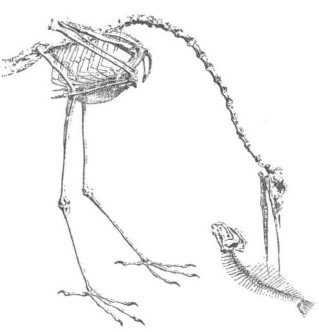

 GEORGE E. GIFFORD, JR.
GEORGE E. GIFFORD, JR. 